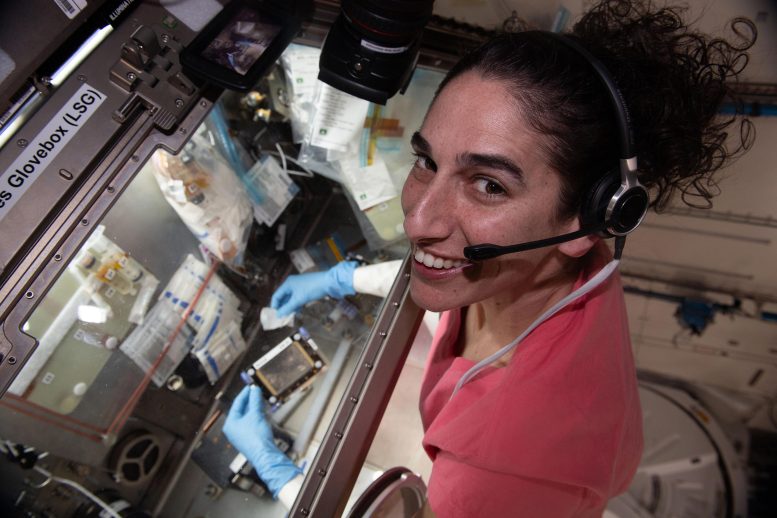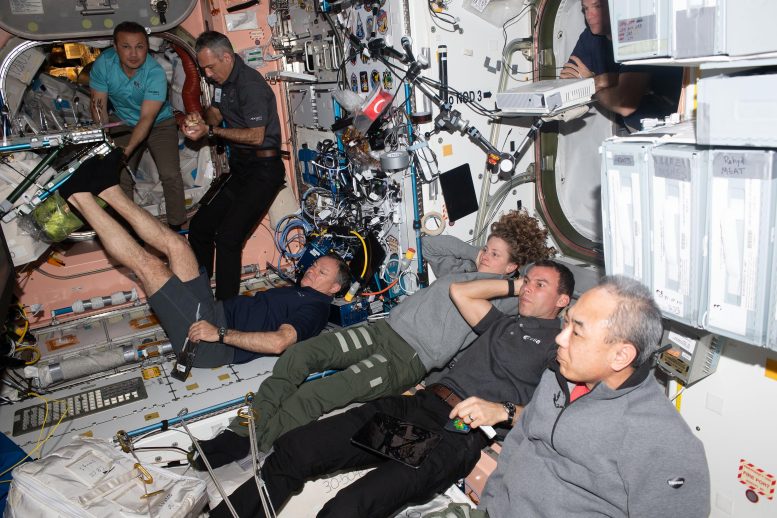The last rays of an orbital sunset illuminate Earth’s atmosphere in this photograph from the International Space Station as it orbited 259 miles above Central America. In the foreground from left are Northrop Grumman’s Cygnus resupply ship, with its prominent cymbal-shaped UltraFlex solar arrays, and the Soyuz MS-24 crew spacecraft. Credit: SciTechDaily.com
The International Space Station (ISS) has returned to its standard configuration of seven Expedition 70 crew members conducting advanced microgravity research and orbital lab maintenance. The four Axiom Mission 3 guests ended their stay at the orbital outpost on Wednesday and are targeting a return to Earth on Friday.
Advancements in Space Research
Biomedical science and space physics dominated the research schedule on Thursday as the crew investigated human immunity, robotic surgery, and optical fibers. The investigations have the potential to improve astronaut health, expand commercial space opportunities, and benefit the communications industry on Earth.

NASA astronaut and Expedition 70 Flight Engineer Jasmin Moghbeli works inside the Life Science Glovebox for the Microgravity Associated Bone Loss-A investigation. She was processing bone cell samples obtained from human donors on Earth and exploring space-caused bone loss. Results may help doctors learn how to protect and treat astronauts on long-term missions and inform treatments for bone conditions on Earth. Credit: SciTechDaily.com
Health Studies in Space
Flight Engineers Jasmin Moghbeli of NASA and Satoshi Furukawa from JAXA (Japan Aerospace Exploration Agency) began Thursday morning collecting their blood and saliva samples for analysis. Next, Commander Andreas Mogensen spun the blood samples in a centrifuge preparing the samples for stowage in a science freezer and others for placement in an incubator. The high-flying lab work will help doctors understand how spaceflight impacts an astronaut’s immune system.
Maintenance and Experiments
Moghbeli then spent the afternoon, assisted by cosmonaut Oleg Kononenko, inspecting the condition of structures inside the Zvezda service module. Furukawa collected metallic samples exposed to extreme heat and then cleaned the inside of the Electrostatic Levitation Furnace, a specialized, high-temperature furnace. Mogensen later photographed the Moon and then readied the Columbus laboratory module for the installation of a new Metal 3D Printer.

Members of the Axiom Mission 3 (Ax-3) and Expedition 70 crews join each other for movie night inside the International Space Station’s Harmony module. From left are, Ax-3 Mission Specialist Alper Gezeravcı; Ax-3 Pilot Walter Villadei; Ax-3 Commander Michael López-Alegría; Expedition 70 Flight Engineer Loral O’Hara from NASA; Ax-3 Mission Specialist Marcus Wandt; and Expedition 70 Flight Engineer Satoshi Furukawa from JAXA (Japan Aerospace Exploration Agency); partially obscured at top right is, Expedition 70 Commander Andreas Mogensen from ESA (European Space Agency). Credit: SciTechDaily.com
Technological Innovations and Maintenance
NASA Flight Engineer Loral O’Hara installed a miniature surgical robot in the Destiny laboratory module that will demonstrate remotely controlled, or tele-operated, surgical techniques from Earth. Afterward, O’Hara worked in the Microgravity Science Glovebox testing the production of optical fibers superior to those manufactured in Earth’s gravity environment.
Prior to assisting Moghbeli, Kononenko strapped on a sensor-packed cap that measured his responses while practicing futuristic spacecraft and robotic piloting techniques on a computer. Roscosmos Flight Engineer Nikolai Chub checked out a carbon dioxide removal device and then replaced an air conditioner power supply unit. Flight Engineer Konstantin Borisov spent his day servicing orbital plumbing gear, testing video hardware, and replacing smoke detectors.





